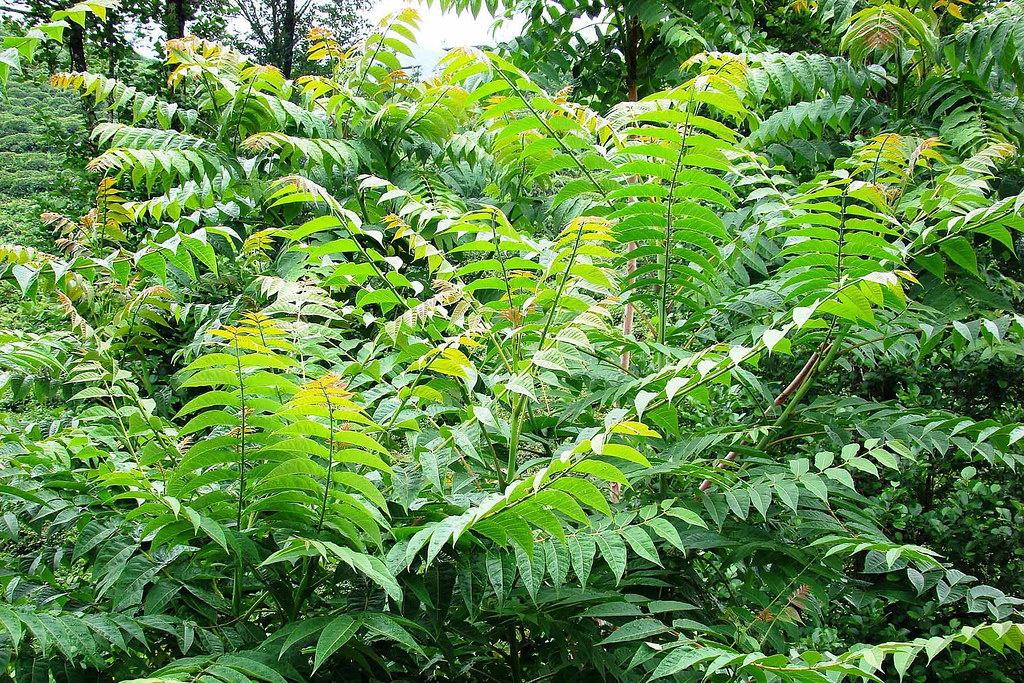by Maria Maring
Land Conservation Coordinator
Tree-of-hell might be a more apt moniker. Add a swarm of spotted lanternflies, and it’s definitely more fitting.
The tree-of-heaven (Ailanthus altissima), also known as Chinese sumac, is one of the most detrimental invasive species—an organism that expands out of its native range and dominates elsewhere—plaguing North America. Native to China and Taiwan, Ailanthus was purposefully brought to the US in the late 1700s. Unfortunately, it has steadily spread since then, and it now devastates native ecosystems from coast to coast.
Tree-of-heaven wasn’t named for any angelic qualities—but for its ability to reach toward the heavens. Indeed, Ailanthus grows incredibly fast. In fact, it can reach 8 feet tall in just its first year of life!
Because it’s so prolific, resilient to unfavorable conditions like compacted soil, and seeps toxins that inhibit other plants from growing, Ailanthus takes over both urban and wild settings swiftly.
And the cherry on top? It stinks! To many, Ailanthus smells like rancid peanut butter or even cat pee.
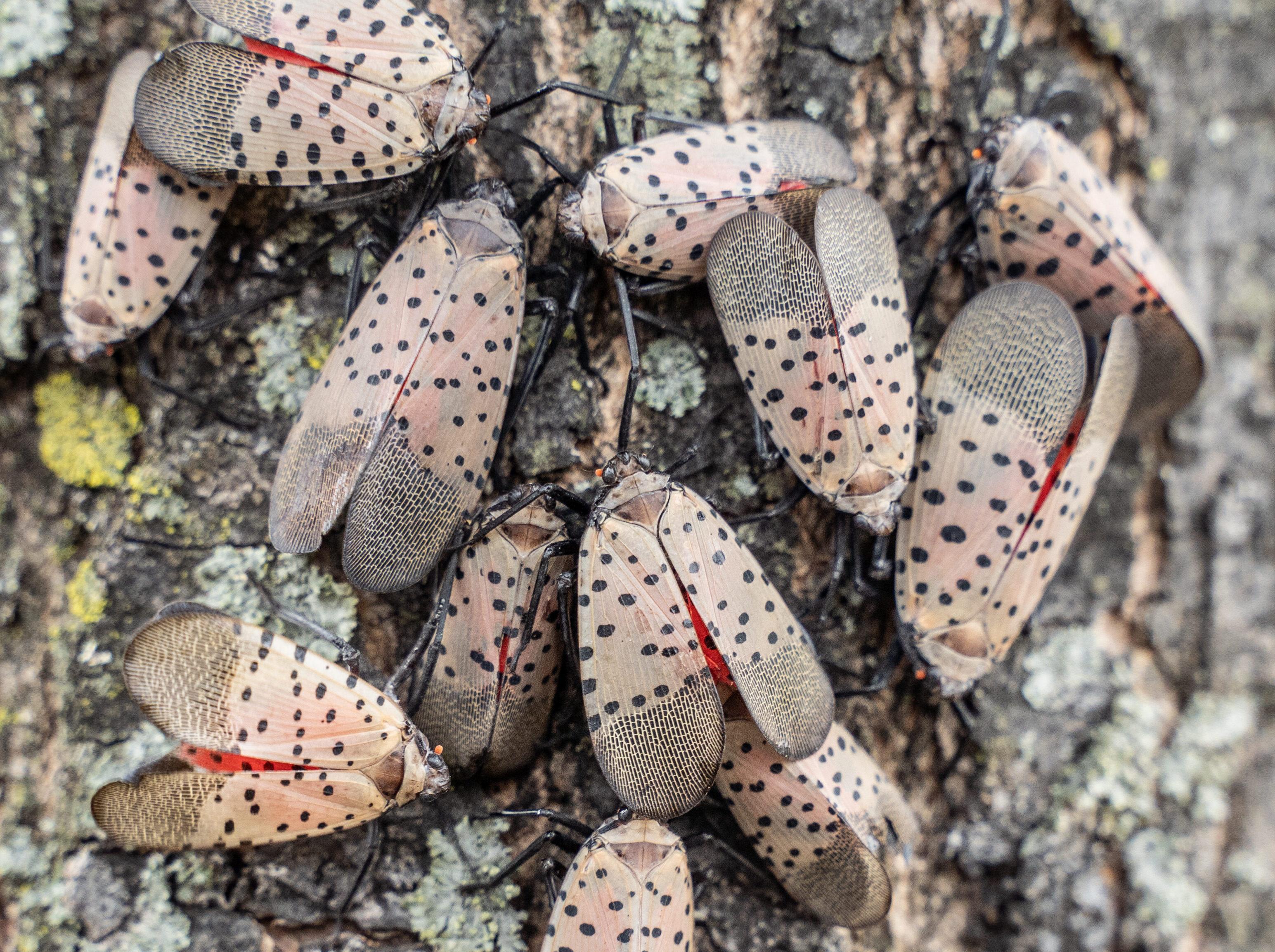
In all seriousness, managing tree-of-heaven in both rural and urban forests is integral to maintaining the health of our native ecosystems. And the need to get Ailanthus under control is even more urgent since the recent arrival of the spotted lanternfly (Lycorma delicatula) in Tennessee.
Another invasive species from Asia, the lanternfly poses an imminent threat to agriculture and, subsequently, the economy. One way to curb the lanternfly’s spread is to eradicate its preferred host, which is—you guessed it—Ailanthus. Managing either species is a two-birds-one-stone deal!
Because it’s almost guaranteed to be in your backyard or on your street right now, learning how to identify and manage tree-of-heaven can immediately benefit your local community and wildlife alike.
Read on to learn how you can help the effort right now!
WHAT DOES AILANTHUS, THE LANTERNFLY’S BEST FRIEND, LOOK LIKE?
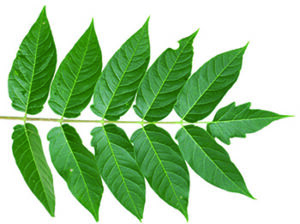
Ailanthus is most identifiable by its pinnately compound leaves. One compound leaf is made up of many leaflets, and pinnate means these leaflets occur side-by-side along a stem-like structure called a rachis. Walnut, ash, and sumac trees all have pinnately compound leaves, too.
A single Ailanthus leaf can have 11 to 25 leaflets, each being 3 to 5 inches long. The whole leaf can be 3 feet long! The rachis is often an orange-pink color. Many folks think Ailanthus looks tropical. And come fall, it turns brilliant shades of yellow and orange.
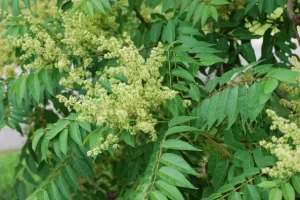
At the height of summer, the tree produces bunches of small, green-yellow flowers. It’s the flowers that earned the tree its unflattering nickname, stinking sumac. They smell like rancid peanut butter or cat pee. Yum!

The fruit of Ailanthus is a samara, a single seed enclosed in a papery wing, best transported by wind. Maple trees’ iconic “helicopters” are also considered samaras. For the Ailanthus, the tree fruits in September and October. In a single year, one tree can produce up to 325,000 seeds, and they grow in bright yellow-pink bunches.
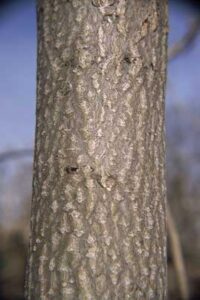
Tree-of-heaven’s bark is smooth, pale grey, and has striations running up and down it. Many folks think the bark resembles a cantaloupe rind or reptile skin. The tree can grow upwards of 80 feet tall, and they often occur in dense groves.
THE RISE OF AILANTHUS
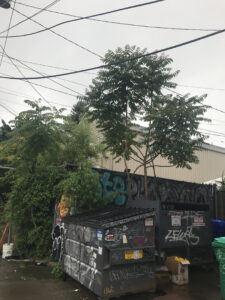
History: Ailanthus was deliberately brought to Philadelphia in 1784 as an ornamental shade plant. Due to its fast-growing nature and resilience to poor, compacted soils, Ailanthus was planted in many cities to beautify streets, create shade, and combat air pollution. Throughout the 1800s, city planners and home gardeners alike heavily utilized Ailanthus.
Additionally, Chinese immigrant workers in Gold Rush California planted Ailanthus around their homes for its cultural significance and medicinal uses. Alas, as is the case with invasive species, Ailanthus began to spread outside of its intended area and take over native ecosystems. Then, its far-reaching roots began to damage sidewalks, roads, and underground utilities, as well.
“Learning how to identify and manage tree-of-heaven can immediately benefit your local community and wildlife alike.”
How it Spreads: Aside from intentional human plantings, Ailanthus spreads in two ways—wind-carried samaras and shoots, or suckers. Despite the fact that a single Ailanthus tree produces thousands of seeds every year, its most common and viable method of worldwide domination is shooting out duplicates of itself via its roots in a process called vegetative reproduction. It’s this phenomenon that causes dense Ailanthus monoculture (the presence or cultivation of one species) thickets, where no other plants can get an edge.
Furthermore, like the Greek Hydra, when injured, Ailanthus aggressively re-sprouts tenfold from the wound. This characteristic makes mitigation extremely difficult. When managed improperly, the tree can come back guns blazing.
To make matters worse, Ailanthus produces a toxin that inhibits neighboring plants from growing. This quality is called allelopathy. Another infamous allelopathic invasive is garlic mustard (Alliaria petiolata). As a result, these invaders not only quickly take over an ecosystem but actively kill its native neighbors.

Today, Ailanthus is everywhere. Introduced in Pennsylvania and California two and a half centuries ago, it has filled in the gaps since then. Appropriately, cultivating and selling Ailanthus in the US is highly discouraged, and even illegal in some places.
HOW TO MANAGE AILANTHUS
How to best manage Ailanthus depends on two factors: the age of the tree and the time of year. Some of these methods require herbicide. Because herbicide is not zero-risk, you should always:
- Do thorough research about best practices, and cross-reference your resources;
- Ensure you have the proper certifications, if necessary;
- Wear all the proper personal protective equipment (PPE);
- And when in doubt, consult with an expert.
Also, it’s important to note that TennGreen Land Conservancy is not a forestry, land management, or invasive species strike team organization. In kind, the following information is intended to let landowners know their options when it comes to Ailanthus management. Conservation takes all of us, after all, so let’s break down those management options:
MECHANICAL
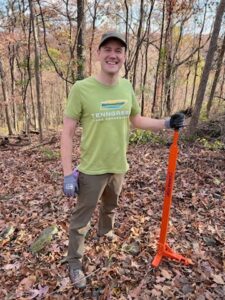
- What is this method? What we mean by mechanical removal is simply pulling the plant out of the ground using your hands or a simple tool.
- When to use this method? Manually removing tree-of-heaven is only viable for young specimen, whose roots are not yet super deep and strong. You’ll want to pull in early summer. This method will be easiest when the soil is moist, after a good rain.
- What will you need? If it’s available to you, you can use a Weed Wrench. You can also use your hands or a pickaxe.
- How to do it? Pull the plant completely out of the ground, careful not to leave any root fragments behind. You can burn the waste or create a low-impact brush pile.
- Note: If bits of roots are left behind in the soil, more tree saplings will grow back. It may be necessary to spot-clean the area for years, pulling saplings until the root system is depleted of resources.
GIRDLING
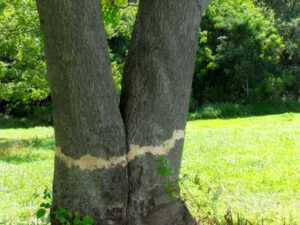
- What is this method? Girdling is when you injure the tree’s tissue around the whole trunk so that it can’t transport nutrients between its leaves and roots, killing it.
- When to use this method? Girdling is best for large, mature trees. This is a good option when herbicides aren’t available or practical. Girdling is most effective when the tree is flowering, in June to July.
- What will you need? A hand axe or a chisel.
- How to do it? At its base, cut the bark along the whole circumference of the tree. The cut should be about 2 inches wide, and it must be deep enough to penetrate the tree’s cambium—its second layer under the bark.
- Note: Girdling only kills the top of the tree, so it probably will re-sprout from the roots. It may be necessary to follow up with more girdling or other management methods for several years until the roots have no more energy left.
HACK-AND-SQUIRT
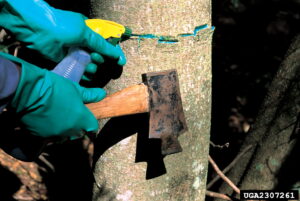
- What is this method? Hack-and-squirt is similar to girdling in that you’ll make cuts, or “hack,” into the cambium; then, you’ll “squirt” herbicide into the cuts.
- When to use this method? The best time of year to do hack-and-squirt is mid to late summer, when the plant is actively transporting nutrients from leaves to roots. This method works great on medium to large trees.
- What will you need? A hand axe, herbicide, and a sprayer bottle or a paintbrush.
- How to do it? At a height that is comfortable to you, make deep, horizontal cuts into the cambium around the tree. Space the cuts no more than one inch apart from each other around the circumference of the tree. Then, using a squirt bottle or paint brush, generously apply herbicide to the cuts, and the tree will absorb it. Importantly, leaving parts of the cambium intact ensure that the herbicide will become systemic through the plant. This is a very local and safe application of herbicide, and it will have little to no effect on the external environment.
- Note: Because Ailanthus is so prolific, several years of treatment may be necessary.
WHAT TYPE OF HERBICIDE SHOULD I USE?
Herbicides with triclopyr or glyphosate are best because they are not active in the soil and, therefore, likely won’t affect non-target plants. For hack-and-squirt application, the Southeast Exotic Pest Plant Council recommends using a 50% herbicide mix (i.e., diluted 1:1 with water). You should always follow the directions on the label when mixing herbicide.
Other methods include cutting down the tree with or without herbicide, spraying the trunk with herbicide (basal application), and spraying the leaves with herbicide (foliar application). However, because the former option results in lots of root suckers that require lots of follow-up treatment over years, we can’t enthusiastically recommend it.
Furthermore, without proper training and a careful hand, the latter two options can also result in unintended effects, so we also can’t recommend it to a beginner Ailanthus hitman. Still, there are tons of reputable resources to learn more about these methods, which you’ll find below.
Although these management options may seem intimidating, they are vital.
A future plagued by Ailanthus and its little friend—the spotted lanternfly—is a future none of us want to envision. Sadly, without management, tree-of-heaven will damage beautifully biodiverse forests, and the lanternfly will wreak untold havoc on our agricultural systems and economy.
To preserve our beautiful state and Tennessean way of life, we have to get ahead of these invasive species.
Additional resources:

